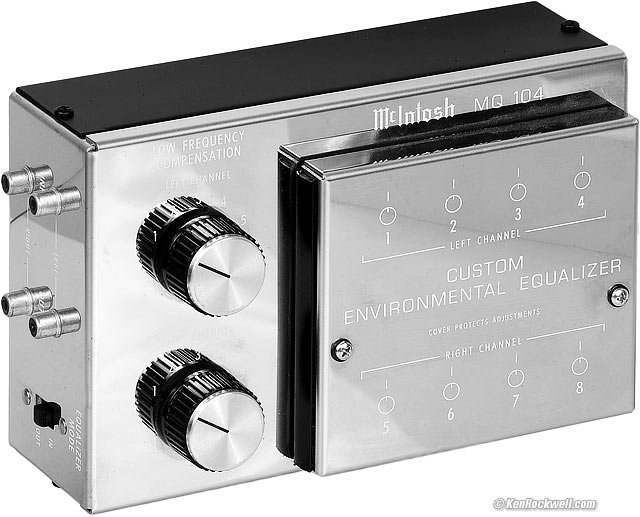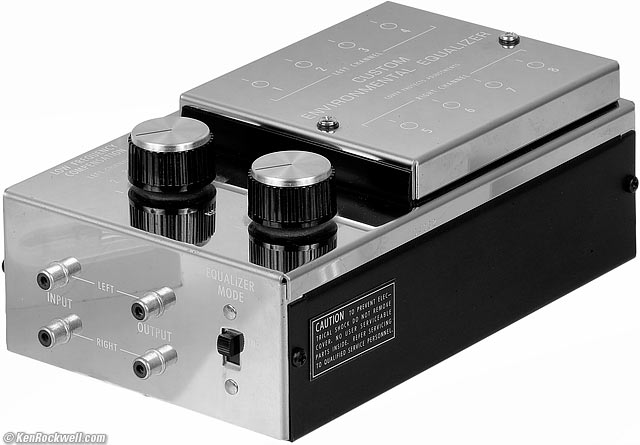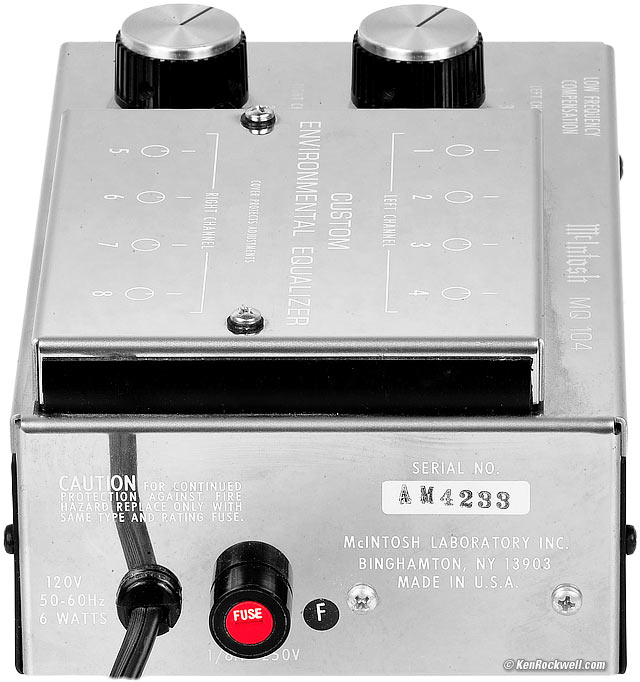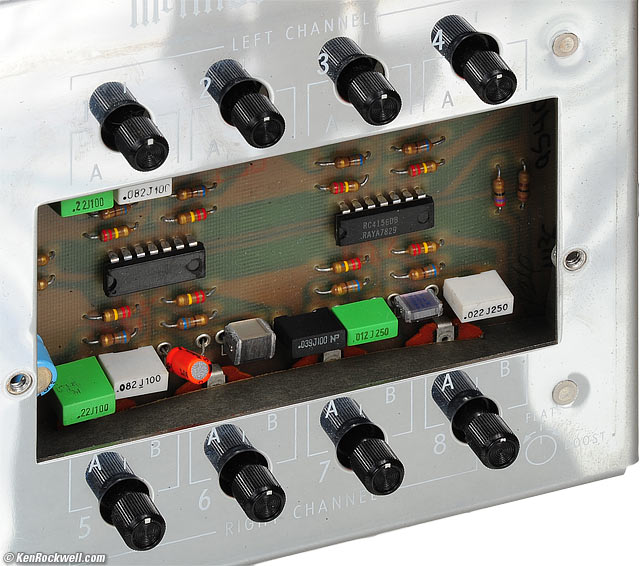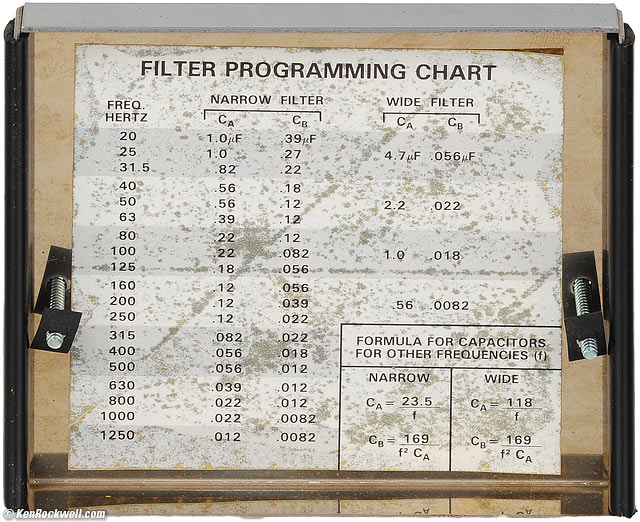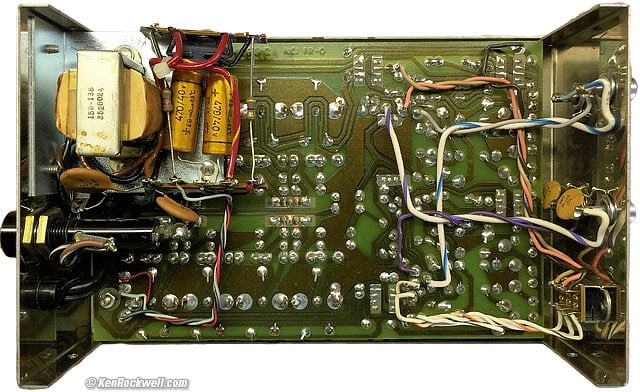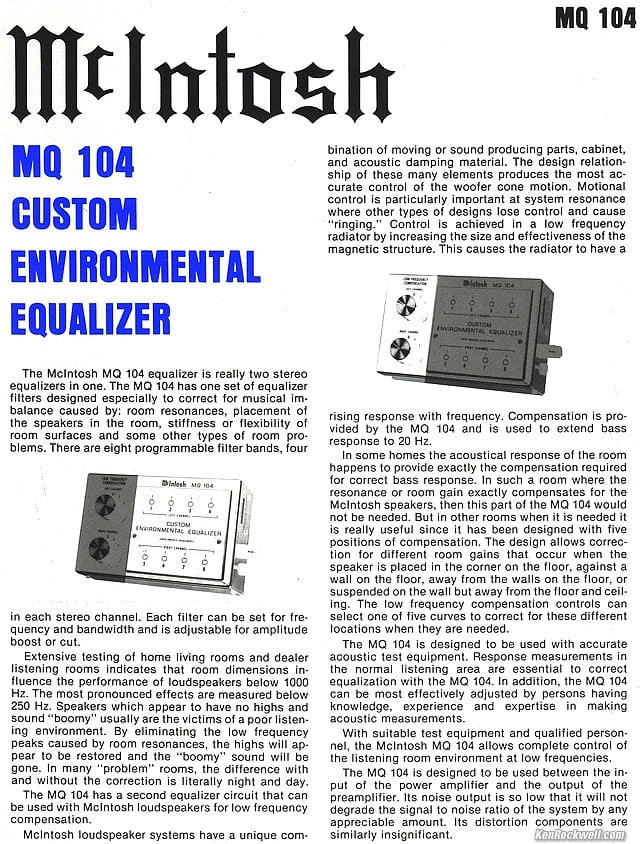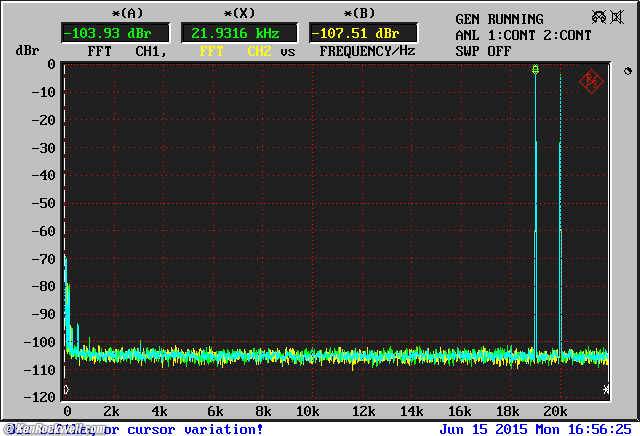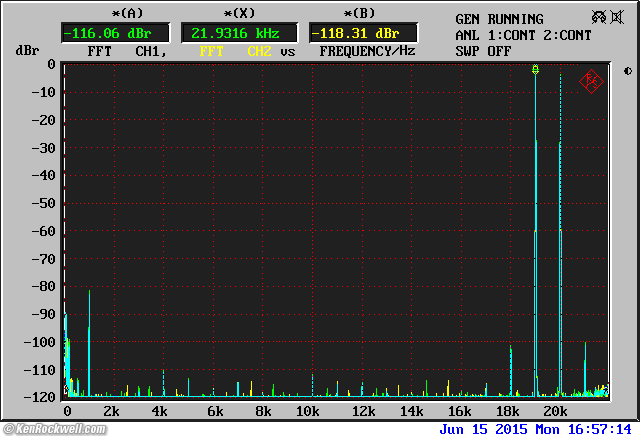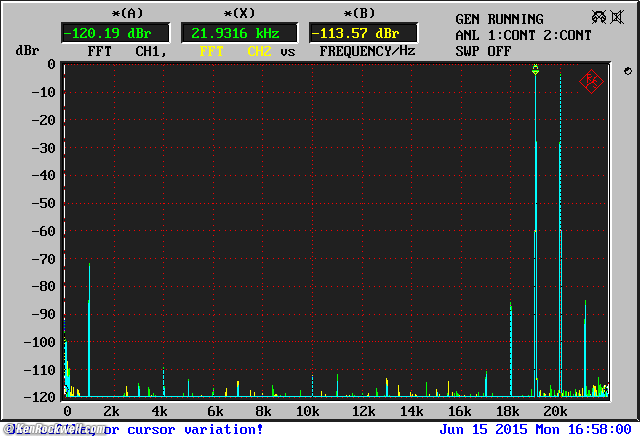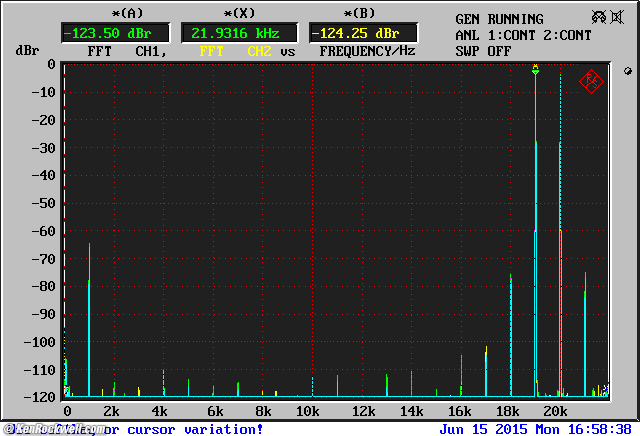Home Donate New Search Gallery Reviews How-To Books Links Workshops About Contact
McIntosh MQ 104
Programmable Bass & Room Equalizer
Made in USA
© 2015 KenRockwell.com. All rights reserved.
Intro Specs Measurements Recommendations More
McIntosh MQ 104 (programmable graphic and dedicated bass equalizer, 3.75W idle power draw, about $150 used). enlarge. I got mine at this link directly to them at eBay (see How to Win at eBay).
Connectors, McIntosh MQ 104. enlarge.
This all-content, junk-free website's biggest source of support is when you use those or any of these links to approved sources when you get anything, regardless of the country in which you live. Buy only from the approved sources I use myself for the best prices, service, return policies and selection. Thanks for helping me help you! Ken.
June 2015 McIntosh Reviews Audio Reviews All Reviews
Newer: McIntosh MQ 107.
McIntosh MQ 104. enlarge.
Introduction top
Intro Specs Measurements Recommendations More
The McIntosh MQ 104 is a dedicated equalizer to optimize low-frequency response of certain McIntosh loudspeaker systems, as well as programmable four-band per channel third or full octave equalizer. It came out around 1980.
It is intended to be set-up with instruments, and then hidden away. The cover minimizes der fingerpoken.
Each channel has four selectable levels of low-frequency boost, or sets flat. These only boost below 100 cycles and boost strongly down to 20 cycles. A 14-cycle infrasonic filter rolls-off response below 20 cycles.
Each of the four programmable third- or full-octave bands may be set to any frequency and set to third or full octave bandwidth using the included set of plug-in capacitors. For instance, with my B&W 801, while I use a 33-band third-octave equalizer, I only use the 16, 25, 40 and 8,000 cycle bands along with a dedicated compensation filter I designed to get flat response to 16 cycles, meaning that the four bands of this equalizer are actually all I need.
It has a mute relay with a 2.2 second turn-on delay.
The EQ IN-OUT switch neutralizes the four hidden, center-detented rotary potentiometers of the 4-band programmable equalizer. The IN-OUT switch does not bypass this equalizer and does not cancel the low-frequency boost selected with the knobs.
Circuitry
The circuitry is curiously primitive for a set of op-amp filters. I designed and built better stuff than this back in the 1970s.
It has an unregulated supply, simply using series resistors to drop ±20V voltages to ±15V. Different resistor values are used to try to get the voltages correct for the different loads of the positive and negative rails. In actual operation, I measure the supply rails at +17.15 V and -16.32 V.
The output coupling capacitors, which aren't really needed, are skimpy 3.3 µF polarized electrolytics.
You'll see that the response curves are good enough for audio, but the 5% metal-film resistors and unspecified capacitor tolerances lead to about a decibel or more variation between channels. Sloppy, but saves a few pennies.
The muting relay makes or breaks the connection between the output series R & C and the output op-amp. It doesn't short the outputs to ground, but leaves about a 12.6 kΩ AC resistance to ground as seen from the output connectors.
IC part number 133-065 is Raytheon RC4156DB.
IC part number 133-054 is CA3140S op-amp.
Specifications top
Intro Specs Measurements Recommendations More
Input
2.5 volts.
27 kΩ.
Unity gain.
Output
2.5 volts into 27 kΩ or more.
Output source impedance: 600 Ω.
The output is coupled through small capacitors, so don't load this with 600 Ω or you will lose low-frequency response (see measurements).
Frequency Response
20 ~ 20,000 cycles.
Noise
Flat: 90 dB below 2.5V rated output (79 µV).
Worst case: 85 dB below 2.5 V rated output (141 µV).
Distortion
Harmonic and IM Distortion: < 0.1% from 20 ~ 20,000 cycles at rated output.
Equalization
Low Frequency Boost
Four levels of boost (numbered 2 through 5) optimized for early McIntosh speakers.
Flat setting: marked "1."
Maximum boost: 17 dB at 20 cycles.
Programmable Filters
McIntosh MQ 104 programmable filters. enlarge.
4 programmable filters per channel.
Each is independent and may be programmed for standard 1/3 octave center frequencies from 20 to 1,000 cycles with the set of included plug-in capacitors.
Lead spacing for plug-in capacitors: 0.3" (5/16" or 7.62mm)
Bandwidth is programmable for 1/3 or one octave.
±12 dB narrow.
±15 dB, wide.
Controls detented at zero.
McIntosh MQ 104 filter programming chart (inside lid). enlarge.
8,000 cycles: 0.00294 µF & 900 pF narrow; 0.0148 µF & 179 pF wide.
16 cycles: 1.47 µF & 0.45 µF narrow; 7.38 µF & 0.0895 µF wide.
12.5 cycles: 1.88 µF & 0.58 µF narrow; 9.44 µF & 0.115 µF wide.
Quality
Made in Binghamton, NY, USA.
Steel case, glass-epoxy circuit boards.
Size
3-1/2 x 8-3/4 x 5-1/4 inches HWD including knobs and protrusions, but not allowing for plugs.
Weight
4-3/4 pounds. (2.15 kg).
6-1/4 pounds. (2.83 kg) in shipping carton.
Power
120 VAC, 50-60 cycles.
Rated 6 watts. Actually draws 3.75W at 118 VAC.
1/8 ampere 3AG fuse.
McIntosh MQ 104 . enlarge.
Catalog Page
McIntosh MQ 104 catalog page. enlarge.
Measurements top
Intro Specs Measurements Recommendations More
Gain Input Levels MOL Output Impedance
Noise Frequency Response THD DFD
These measurements are made with an advanced, factory-calibrated Rohde & Schwarz UPL laboratory analyzer. The traces from the Rohde & Schwarz UPL laboratory analyzer are color coded for the Left Channel 1 and for the Right Channel 2. When they don't lie on top of each other, it's due to channel imbalance. When they do lie on top of each other, the trace turns blue.
Unless otherwise specified, all measurements are RMS, fed from a 5Ω source impedance at 1,000 cycles at 1 V and loaded by 200 kΩ.
Gain measurements top
+0.0177/-0.6656 dB, EQ OUT.
-0.0513/-0.7815 dB, EQ IN.
Maximum Input Level measurements top
> 10 V at 1,000 cycles with no EQ and Low Frequency Compensation at 1.
10.0 V at 20 cycles with no EQ and Low Frequency Compensation at 1.
4.96 V at 20 cycles with no EQ and Low Frequency Compensation at 2.
2.92 V at 20 cycles with no EQ and Low Frequency Compensation at 3.
1.90 V at 20 cycles with no EQ and Low Frequency Compensation at 4.
1.25 V at 20 cycles with Low Frequency Compensation at 5.
Maximum Output Level measurements top
10.47 V at 0.1% THD into 200 kΩ.
I measure the supply rails at +17.15 V and -16.32 V.
Output Source Impedance measurements top
560.4 Ω at 1,000 cycles.
2,083 Ω at 20 cycles due to the output coupling capacitor.
Output Noise measurements top
No EQ
-95.0 dBV, A-weighted.
-91.0 dBV, 1 ~ 22,000 cycles unweighted.
EQ all boosted to the maximum
-88.8 dBV, A-weighted.
-85.6 dBV, 1 ~ 22,000 cycles unweighted.
Frequency Response: Flat measurements top
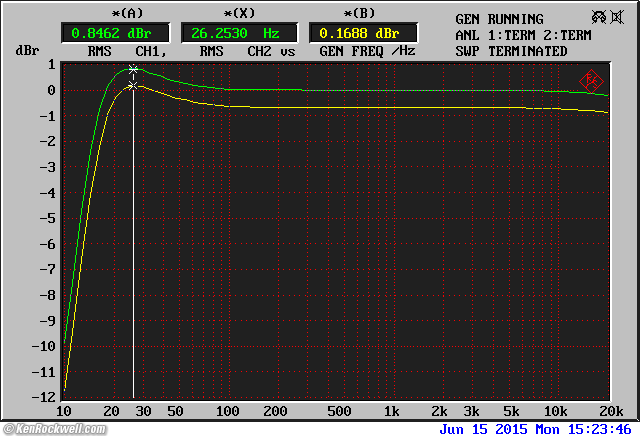
McIntosh MQ 104 Frequency Response.
There's an 0.85 dB boost at 26 cycles, even set to no boost.
While the output source impedance measures 560 Ω and is rated 600 Ω, the output coupling capacitor is relatively small, so if actually loaded by 600 Ω will lose low-frequency response:
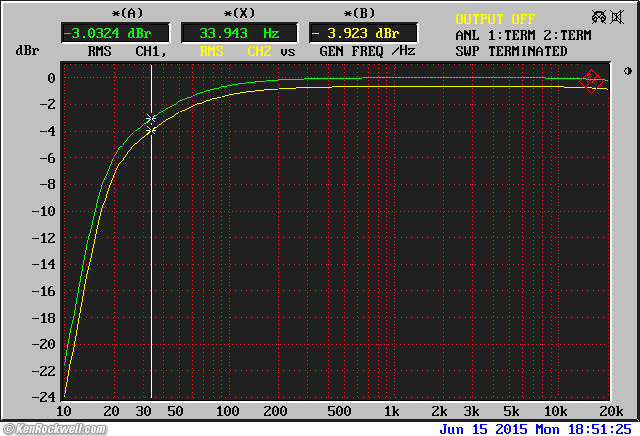
Frequency Response, 600 Ω load.
3 dB down at 34 cycles when loaded by 600 Ω.
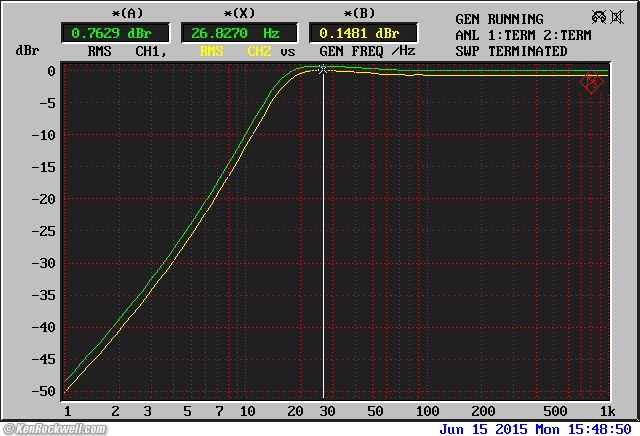
McIntosh MQ 104 Infrasonic Frequency Response.
There's a 12 dB/octave subsonic filter, -3 dB at 14 cycles.
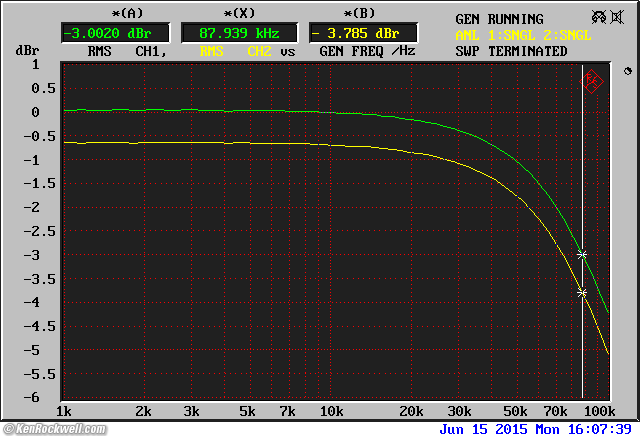
McIntosh MQ 104 Ultrasonic Frequency Response.
-3 dB at 88 kc, swell.
Frequency Response: LF Boost
These are composite plots of all five settings of the LOW FREQUENCY COMPENSATION controls.
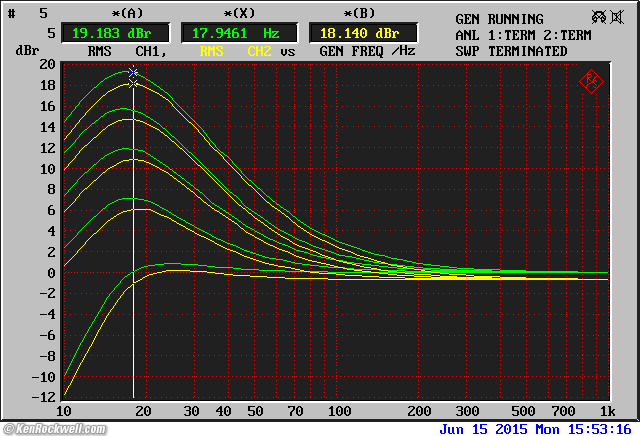
McIntosh MQ 104 LOW FREQUENCY COMPENSATION. 5 (maximum boost) at top, 1 (flat) at bottom.
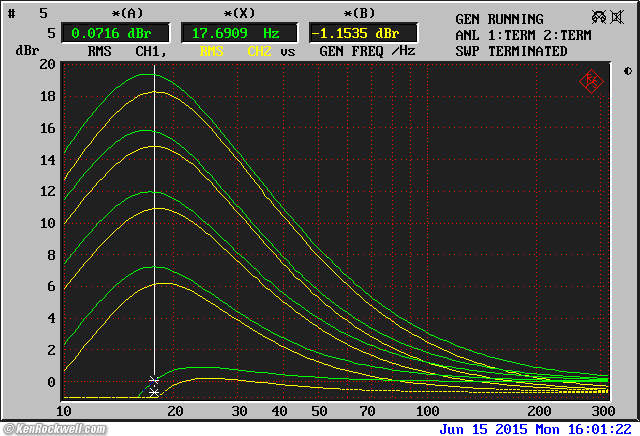
McIntosh MQ 104 LOW FREQUENCY COMPENSATION, detail. 5 (maximum boost) at top, 1 (flat) at bottom.
Boost looks like 8 dB/octave maximum; i/m not sure why this isn't 12 dB per octave to match a sealed-box loudspeaker.
Frequency Response: 4-Band Equalizer
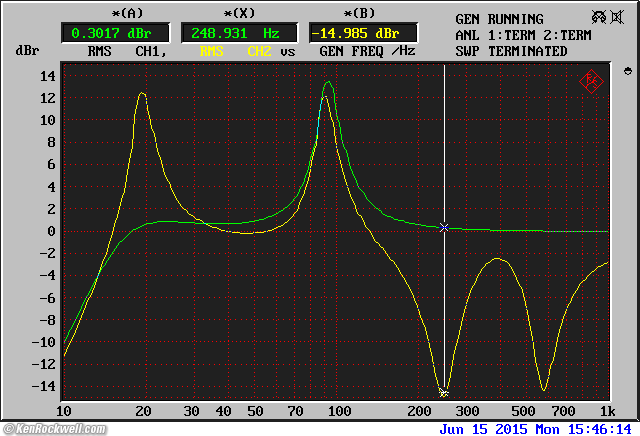
McIntosh MQ 104 Frequency Response, maximum boost or cut, random bands programmed.
Frequency Response: Tutti
Here's the response at maximum bass boost (level 5) as well as some of the bands set to maximum. Doing this one can get a healthy 31 dB of boost at 20 cycles:
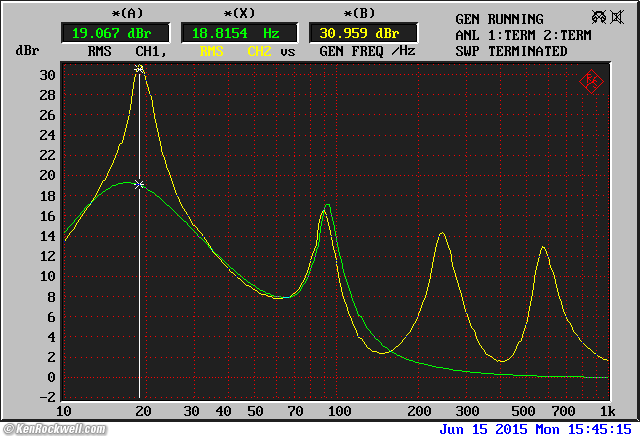
McIntosh MQ 104 Frequency Response, maximum LF boost and programmed filters set to maximum boost
THD measurements top
For these measurements, I left the programmed filters flat and set the LF boost to 3.
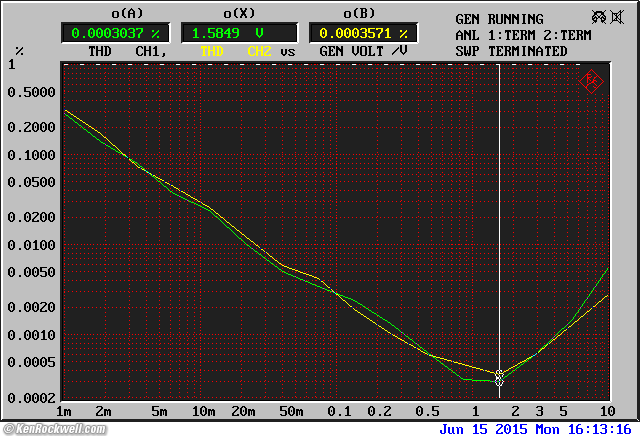
McIntosh MQ 104 THD at 1 kHz.
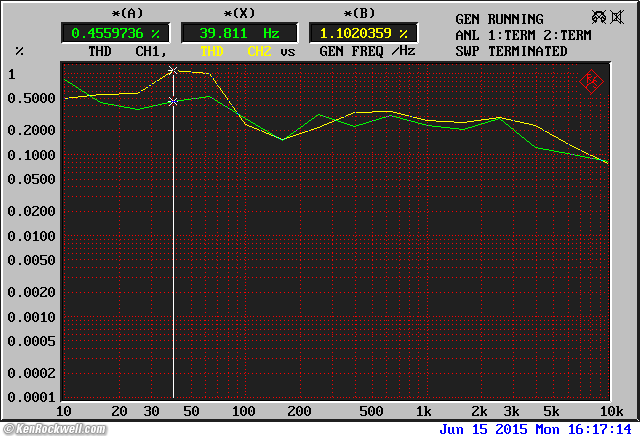
McIntosh MQ 104 THD at 1 mV.
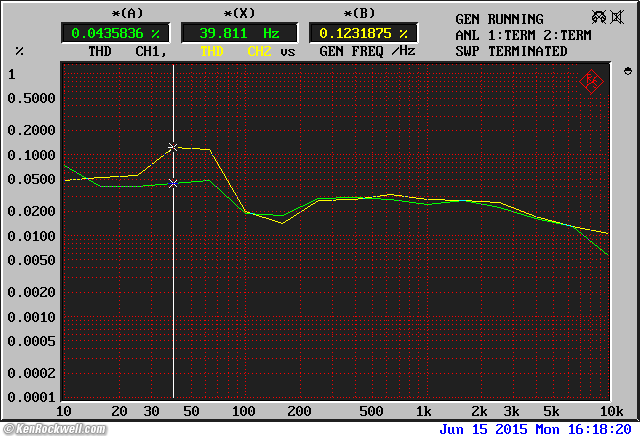
McIntosh MQ 104 THD at 10 mV.
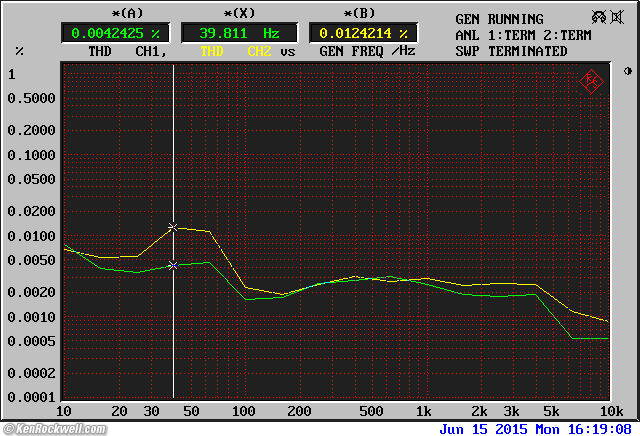
McIntosh MQ 104 THD at 100 mV.
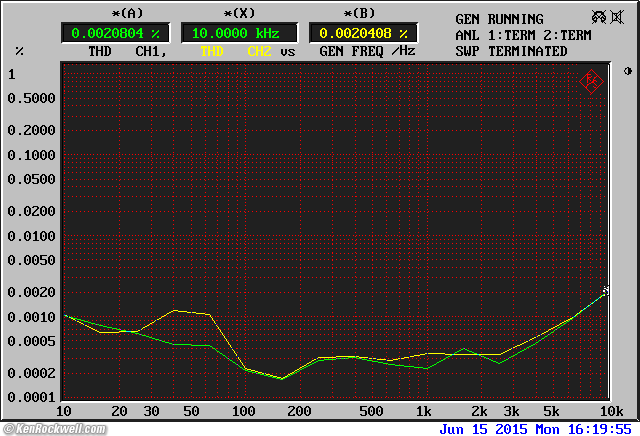
McIntosh MQ 104 THD at 1 V.
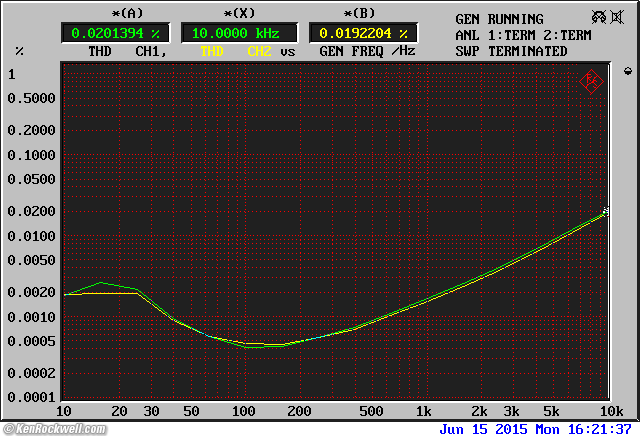
McIntosh MQ 104 THD at 9 V, set flat.
At this high level I set it flat (#1), but at 10 V it clipped at 26 cycles due to the slight boost. Therefore I measured this at 9 V.
As you can see at 1 V and more so at 9V, the operational amplifiers are getting into slew-rate problems at these foolish levels at high frequencies. The integrated circuits are soldered in, so don't worry about updating them.
DFD measurements top
DFD, 19+20 kc 1:1 at 100 mV total RMS.
No DFD at 100mV, swell.
DFD, 19+20 kc 1:1 at 1 V total RMS.
This is a more DFD than I usually like to see, but never should you ever have this level at 19 or 20 kc. This again I presume is the limitation of the ICs.
DFD, 19+20 kHz 1:1 at 3.16 V total RMS.
DFD, 19+20 kc 1:1 at 7.0711 V total RMS.
3.75 watts measured at 118 VAC.
Recommendations top
Intro Specs Measurements Recommendations More
These are inexpensive and versatile little equalizers. They are smaller and easy to hide compared to any graphic equalizer. Happy wife, happy life.
If you find my work here helpful, this all-content, junk-free website's biggest source of support is when you use this link directly to them at eBay (see How to Win at eBay) or any of these links to approved sources when you get anything, regardless of the country in which you live. Buy only from the approved sources I use myself for the best prices, service, return policies and selection.
Thanks for helping me help you!
Ken.
More Information top
Intro Specs Measurements Recommendations More
Roger Russell's page on the MQ 104
Roger Russell's page on loudspeaker equalizers
Help me help you top
I support my growing family through this website, as crazy as it might seem.
The biggest help is when you use any of these links to approved sources when you get anything, regardless of the country in which you live. It costs you nothing, and is this site's, and thus my family's, biggest source of support. These places have the best prices and service, which is why I've used them since before this website existed. I recommend them all personally.
If you find this page as helpful as a book you might have had to buy or a workshop you may have had to take, feel free to help me continue helping everyone.
If you've gotten your gear through one of my links or helped otherwise, you're family. It's great people like you who allow me to keep adding to this site full-time. Thanks!
If you haven't helped yet, please do, and consider helping me with a gift of $5.00.
As this page is copyrighted and formally registered, it is unlawful to make copies, especially in the form of printouts for personal use. If you wish to make a printout for personal use, you are granted one-time permission only if you PayPal me $5.00 per printout or part thereof. Thank you!
Thanks for reading!
Mr. & Mrs. Ken Rockwell, Ryan and Katie.
Home Donate New Search Gallery Reviews How-To Books Links Workshops About Contact

